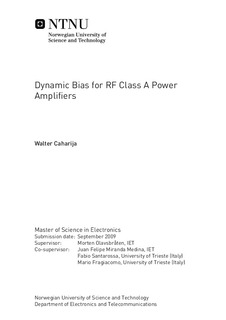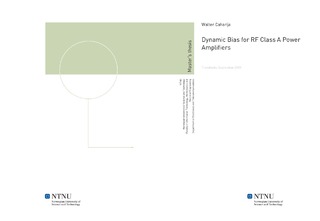| dc.description.abstract | This thesis focuses on class A radio frequency power amplifiers in dynamic supply modulation architectures (dynamic bias). These are promising efficiency enhancement techniques where the device is driven harder by varying its bias signals. Non linearities that arise are considered as digitally compensated through, for example, digital predistortion (DPD). Bias signals are meant as functions of the PA?s output power level (P out). Therefore, the input power level (P in) as well as the feeding signals are thought as quantities the amplifier need to give a certain P out. The selected set of bias points the device sweeps through is called bias trajectory or bias path. A tool to find a suitable bias trajectory is developed considering the requirements a class A power amplifier should satisfy: high power added efficiency, acceptable gain and output phase variations as P out changes (allowing a DPD algorithm to be effective), low harmonic distortion and not too complicated bias signals patterns. The tool consists of two softwares: ADS and Matlab. ADS simulates the device under test while Matlab allows the user to analyze the data and find a suitable bias path. Once a trajectory is identified, ADS can sweep along it and give more information on linearity and efficiency through, for instance, 2-tone harmonic balance simulations. Note that only static characteristics are evaluated and memory effects disregarded. The path searching algorithm is then applied to a HBT transistor, at a frequency of 1.9GHz and to a complete pHEMT class A PA (frequency of 6Ghz). In both cases a suitable trajectory is identified and analyzed back in ADS. The Matlab plots are qualitatively similar to each other when switching form one device to another. The HBT transistor has then been tested in the laboratory and static measurements have been performed showing good agreement with simulations. Keywords: Bias trajectory, dynamic bias, efficiency, HBT, linearity, pHEMT, power amplifier | nb_NO |

